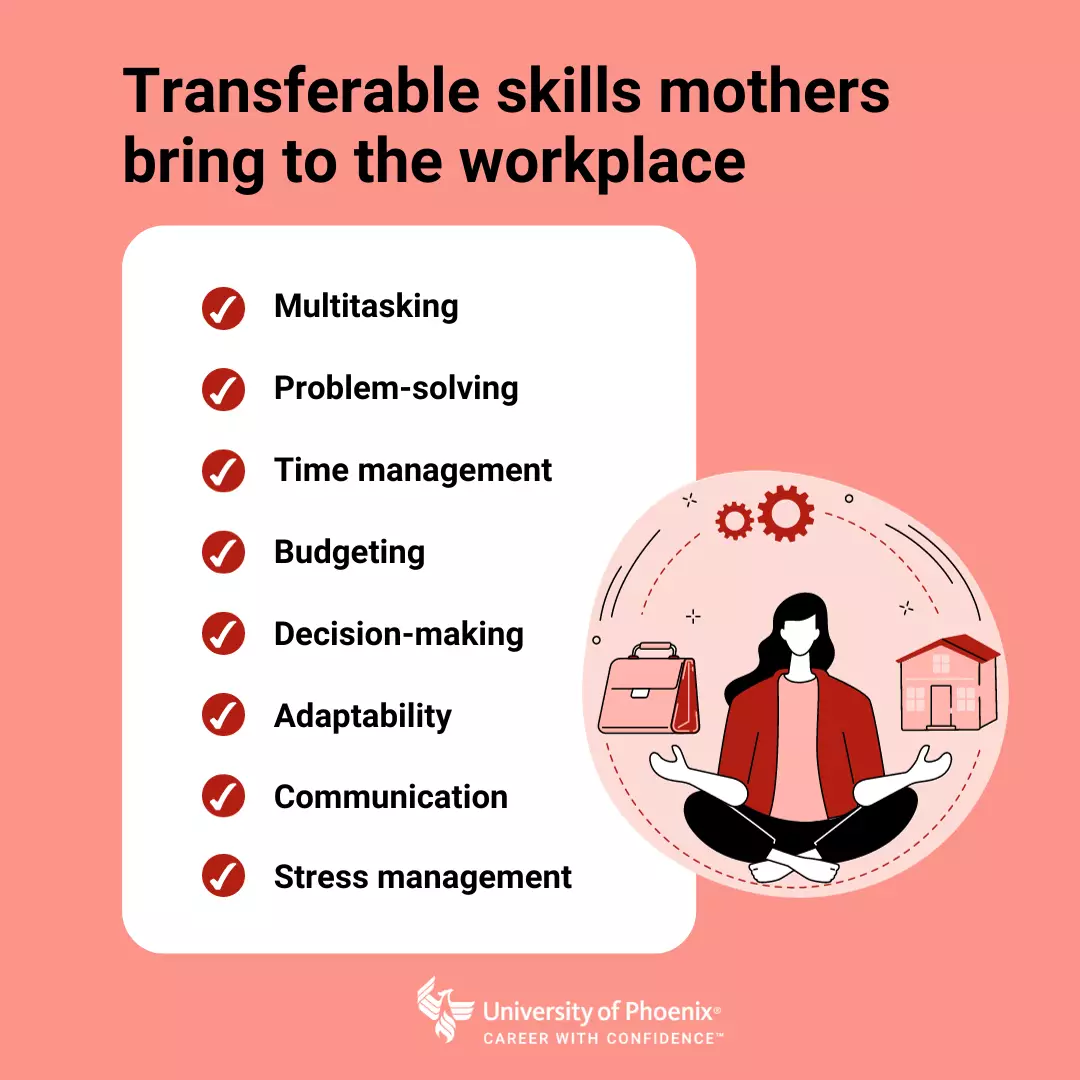How to bring your mom game to work for career growth

Written by Elizabeth Exline

At a glance
- According to the M.O.M.™ report from University of Phoenix and Motherly, 64% of lower-income moms say pursuing a career feels unattainable.
- Workplaces can better support working moms by offering flexible schedules, individual help and skill development.
- Read the full M.O.M.™ report at the University of Phoenix Career Institute® site.
As any working mother can tell you, balance is like perfection: It’s a nice thing to strive for, even if you don’t really expect to achieve it.
More possible (and sustainable) might be to puzzle all the pieces together in an evolving whole. Work, family, school — they can’t all be first all the time, nor can one of them always come in last. This was one reality the Mothers Overcome More™ (M.O.M.™) report aimed to address. Commissioned by the University of Phoenix Career Institute® and Motherly, it explores which barriers prevent career growth for working moms.
As the report underscores, moms have plenty to offer the workforce if only the workforce would facilitate the contribution. Specifically, working moms need more:
- Flexibility
- Support
- Skill development opportunities

Ruth Veloria
Chief Strategy and Customer Officer, University of Phoenix
Here, Ruth Veloria, the chief strategy and customer officer at University of Phoenix , explores which barriers keep moms from realizing their full professional potential and how everyone can play a part in removing them.
Why working moms matter
At a school where 70% of the students are women and 63.1% have dependents , the advantages and disadvantages of being a working mom feel particularly relevant.
“Since we are really focused on careers and growth in people’s careers, we wondered what would be the barriers, particularly for women, that could stand between them and their careers,” Veloria says, explaining the impetus behind the M.O.M. report.
The University had already recognized a certain level of inertia among students when it came to leveraging available career tools, she adds. Why might these students who’d already taken the first step toward owning their careers (by enrolling in a degree program) not take advantage of these resources?
“You know, you’re doing this extra work on top of your regular work, so it can feel like the right thing to do is postpone all of that career engagement until later in the program,” Veloria says. “It felt like it would be important to understand a little bit more about what those struggles are so that we can provide better solutions.”
What working moms are saying
The results of the M.O.M. report revealed a landscape where “getting by” gets the lion’s share of moms’ attention and energy.
Consider the following:
- 64% of lower-income moms say they would like to pursue a career, but it feels unattainable.
- 53% of those mothers lack a role model with a career.
- The top workplace stressors for lower-income mothers are not making enough money and limited opportunities for advancement.
Yet these same moms also have usable skills to offer the workforce.
Like what exactly? Organization for starters. As any mother can tell you, keeping multiple schedules aligned so that everyone gets where they need to be (and then picked up) is part and parcel of motherhood.
In Veloria’s own home, she says, they worked off of spreadsheets to ensure drop-offs and pickups were completed properly.
Moms also know how to negotiate, whether that’s to get the dishwasher unloaded and breakfast on the table or to get the playroom picked up.
“Running a family is very much about being able to calibrate what it is that’s going to make each person tick,” Veloria observes. “And these are stories that we could probably do a better job of telling our employers. ‘OK, this is what I’m doing on a daily basis that makes me a great team leader, that makes me better organized, that makes me a good project manager.’”

How the workplace can better support working moms
If working moms, especially those in lower income brackets, think career growth is a luxury they don’t have time to pursue, Veloria and others would like to change that perception. Admittedly, that starts with the women themselves. “You have to envision your future self, and you have to say, ‘I’m now committing to that future state of who I want to be,’” Veloria says.
Prioritizing that vision may mean a variety of things — an appointment with a career advisor , an updated resumé
, a professional development course
or a degree program
. But it also means the workplace needs to do a better job of helping mothers realize their full potential.
According to the M.O.M.™ report and Veloria, this starts with three key factors.
Flexibility
“Flexibility was the No. 1 thing that came out of the report,” Veloria says. That will surprise exactly no parent. Being able to step away to pick up kids from school or to work from home when they’re sick can spell the difference between a job that is tenable and a job that is not.
Inflexible hours or structure take their toll on employer and employee alike. According to the M.O.M. report, one-third of lower-income mothers switched jobs in the past year because of inflexibility, poor management or inadequate compensation.
Veloria has personal experience with the advantages of flexibility. When her oldest daughter was young, she worked at a company that offered a four-day workweek at 80% of the salary.
“On Fridays I could invest in spending time with my daughter, and that helped with the bonding. That helped with feeling like I had a chance to go to the doctor and those kinds of things,” Veloria explains. “So, that’s where the flexibility in the report most resonated with me, because I was lucky enough to get a job that had built in a way to do that.”
Individual support
If flexibility is offered at a company level, support is within the purview of managers to offer.
Veloria, for example, oversees a mom on her team whose “accountable and responsible” work ethic makes it easy for Veloria to accommodate.
“I don’t start meetings before 9:30 a.m. because she has to drop off her kid at school,” Veloria says. “When the kids are in bed, she might be replying to email and closing out some things.”
This is a benefit of virtual workplaces, Veloria adds, where scheduling tools and meeting platforms make it relatively easy to accommodate employees who have to pop out for school pickup or doctor appointments.
“So, underneath the HR leader, the manager or co-worker can just be sensitive to ‘How am I going to work around [this person’s parental needs]?’” Veloria says.
Skill development
One of the key takeaways from the M.O.M. report is that, if moms are to make career growth a reality, they have to invest in skill development. In fact, 56% of lower-income moms surveyed say that further education or professional development could enhance their career prospects significantly.
This fact presents an opportunity for employers. HR leaders need to ask themselves how they’re investing in their employees, Veloria says.
“That’s what a lot of people want these days,” she says, “is to feel like they’re on a pathway to some kind of career success.”
Career early and often
While employees can’t determine a company’s commitment to flexibility or skills development programs, they can invest in themselves and work toward a career that offers those things.
“When we begin with a goal and work with that end in mind, we don’t lose ourselves in the constant cycle of, ‘Am I making progress?’” Veloria says. “If I begin with an end in mind, I’m more targeted with where I could go next.”
This is one reason why UOPX offers a skills dashboard to students. As students develop skills in each course , they can see their progress in real time. This not only gives them the ability to share their skills with prospective employers, but it can also inspire them to keep working toward their goal. Motivation, after all, can wane in between day care drop-off, deadlines and dinner for five.
Another source of motivation? Community. From social media groups to career advisors, from friends cheering you on to your own kids watching you achieve your goals, having people in your corner can help keep you going.
“You’re not alone,” Veloria says. “Just think about one action that you could do that could bring yourself closer to that goal. Just start.”

ABOUT THE AUTHOR
Elizabeth Exline has been telling stories ever since she won a writing contest in third grade. She's covered design and architecture, travel, lifestyle content and a host of other topics for national, regional, local and brand publications. Additionally, she's worked in content development for Marriott International and manuscript development for a variety of authors.
This article has been vetted by University of Phoenix's editorial advisory committee.
Read more about our editorial process.
Read more articles like this:


